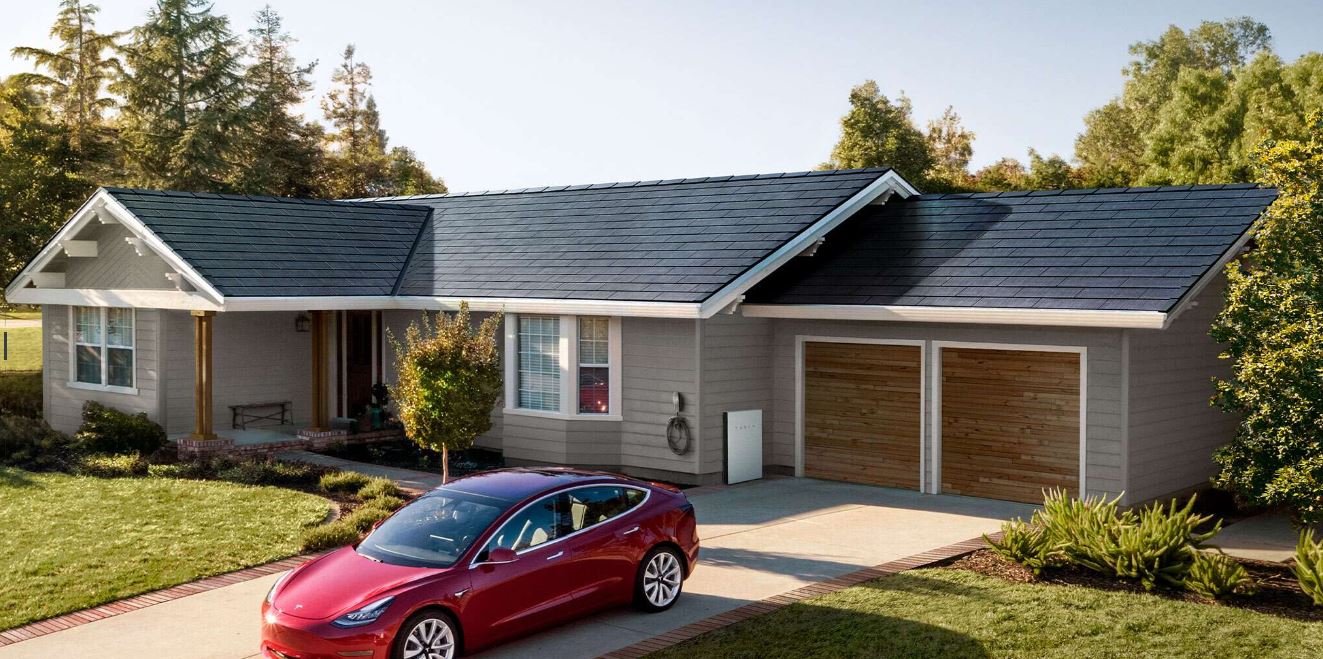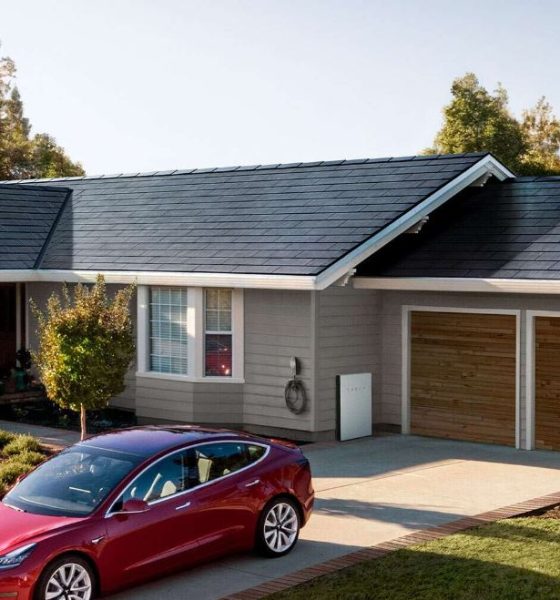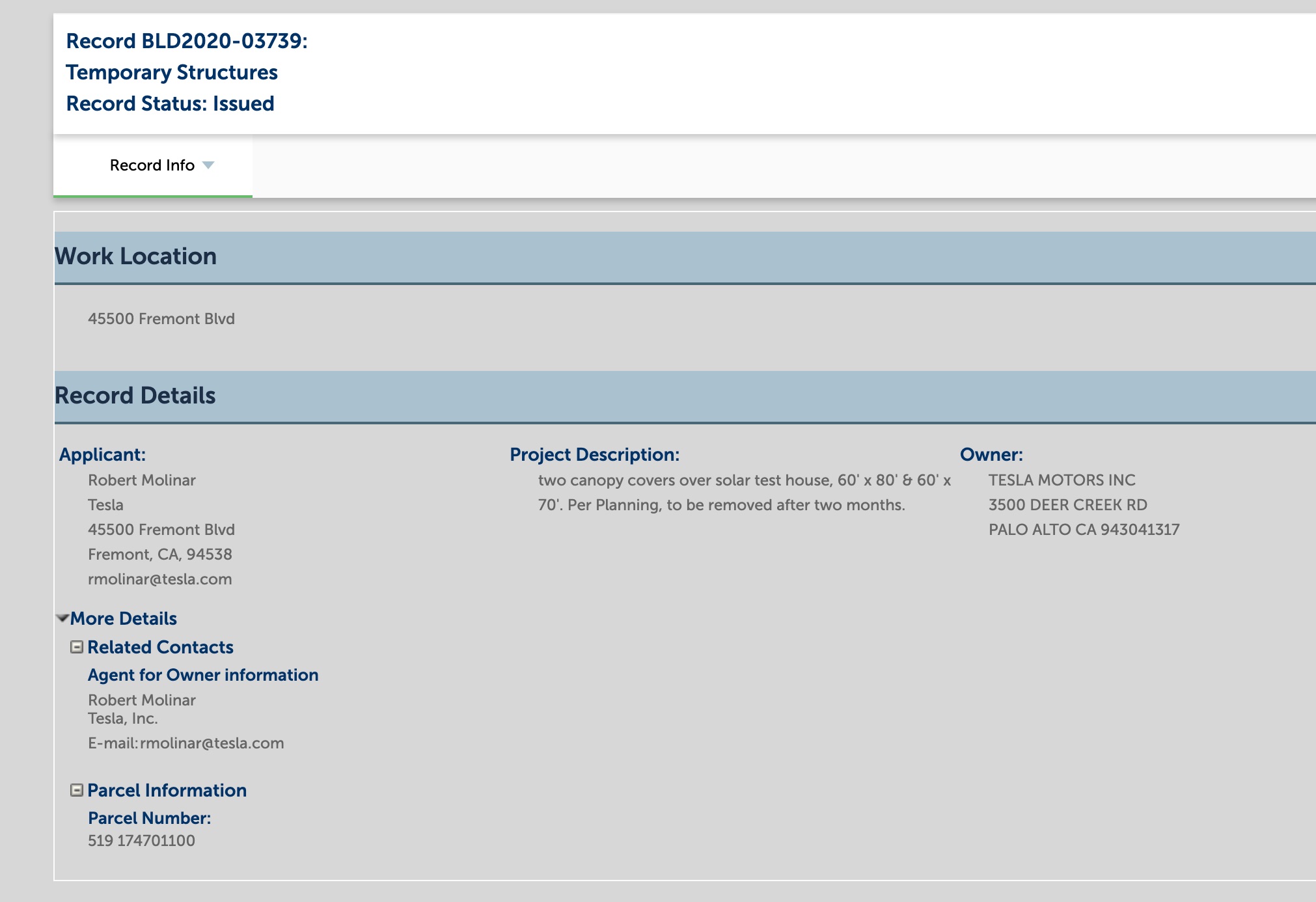

News
Tesla to install canopies for a 'solar test house' at its Fremont factory
Tesla has plans for the installation of new tent-like canopies for a “solar test house” at its factory, according to a new building permit issued by the City of Fremont.
Per the description noted in the initial filing, Tesla is seeking “two canopy covers over solar test house” that measure approximately 60′ x 80′ & 60′ x 70′. The structures will be temporary and removed after two months.
While there’s no indication on the purpose for the canopies, CNBC indicates that the canopies are meant to conceal research and development on its solar test house from prying eyes, and protect the project from potential delays due to rains.
Seeing progress in the efforts of Tesla to install more Solarglass rooftops brings it another step closer to mass producing the third version of the solar roof tiles. Likewise, such developments can help Tesla capitalize on California’s new building requirements that require newly-built homes to have solar systems starting next year. The state is the first in the country to require solar panel installations on single-family homes and multi-family structures.

Based on the 2019 Building Energy Standards in California, the solar requirement increases the cost of building a new home by roughly $9,500 but has the potential to save homeowners about $19,000 in energy bills and maintenance costs over 30 years. The Energy Commission estimates that an average home will save around $80 on cooling, heating, and lighting bills. Customers such as Amanda Tobler from the Bay Area echo the possibility that these numbers can be achieved. The Toblers had their Solar Roof tiles installed in March 2018 and enjoys more than enough power for their house and two plug-in vehicles as a result.
Tesla also recently posted job openings that aim to beef up its installation teams in California, Florida, Nevada, and Texas. The company looks to hire licensed electricians, Solarglass roofers, installers to join its operations who will most likely not install just its solar tiles but also help to put up Powerwalls and regular solar panels.
As the energy company installs more Solarglass rooftops, it will also create more jobs to fill the needs of its facility in Buffalo, New York and possibly save the company $41.2 million in penalties. Tesla promised to produce its solar panels in the said facility, which used $750 million in taxpayers’ money and the deal requires it to generate around 1,500 jobs by April next year.
Tesla CEO Elon Musk says he sees the company’s energy business to grow as big as its electric vehicle business. In Q3, Tesla deployed 43MW of solar or 48 percent more compared to the previous quarter.
“…the really crazy growth for as far into the future as I can imagine. … It would be difficult to overstate the degree to which Tesla Energy is going to be a major part of Tesla’s activity in the future,” he said during with Wall Street analysts.
Tesla started accepting orders for its V3 Solar Roof in October and Musk revealed that it plans to eventually install 1,000 solar roofs a week. Interested homeowners who want a Solarglass rooftop can use the company’s online configurator to estimate the costs. The estimated pricing for a 2,000 sq. ft. roof with 10kW solar is $33,950 after a federal tax credit of $8,550.
As of 2018, there are only 15 to 20 percent of California single-family houses with solar panels installed according to the estimates of the California Building Industry Association.

News
Tesla FSD fleet is nearing 7 billion total miles, including 2.5 billion city miles
As can be seen on Tesla’s official FSD webpage, vehicles equipped with the system have now navigated over 6.99 billion miles.

Tesla’s Full Self-Driving (Supervised) fleet is closing in on almost 7 billion total miles driven, as per data posted by the company on its official FSD webpage.
These figures hint at the massive scale of data fueling Tesla’s rapid FSD improvements, which have been quite notable as of late.
FSD mileage milestones
As can be seen on Tesla’s official FSD webpage, vehicles equipped with the system have now navigated over 6.99 billion miles. Tesla owner and avid FSD tester Whole Mars Catalog also shared a screenshot indicating that from the nearly 7 billion miles traveled by the FSD fleet, more than 2.5 billion miles were driven inside cities.
City miles are particularly valuable for complex urban scenarios like unprotected turns, pedestrian interactions, and traffic lights. This is also the difference-maker for FSD, as only complex solutions, such as Waymo’s self-driving taxis, operate similarly on inner-city streets. And even then, incidents such as the San Francisco blackouts have proven challenging for sensor-rich vehicles like Waymos.
Tesla’s data edge
Tesla has a number of advantages in the autonomous vehicle sector, one of which is the size of its fleet and the number of vehicles training FSD on real-world roads. Tesla’s nearly 7 billion FSD miles then allow the company to roll out updates that make its vehicles behave like they are being driven by experienced drivers, even if they are operating on their own.
So notable are Tesla’s improvements to FSD that NVIDIA Director of Robotics Jim Fan, after experiencing FSD v14, noted that the system is the first AI that passes what he described as a “Physical Turing Test.”
“Despite knowing exactly how robot learning works, I still find it magical watching the steering wheel turn by itself. First it feels surreal, next it becomes routine. Then, like the smartphone, taking it away actively hurts. This is how humanity gets rewired and glued to god-like technologies,” Fan wrote in a post on X.
News
Tesla starts showing how FSD will change lives in Europe
Local officials tested the system on narrow country roads and were impressed by FSD’s smooth, human-like driving, with some calling the service a game-changer for everyday life in areas that are far from urban centers.

Tesla has launched Europe’s first public shuttle service using Full Self-Driving (Supervised) in the rural Eifelkreis Bitburg-Prüm region of Germany, demonstrating how the technology can restore independence and mobility for people who struggle with limited transport options.
Local officials tested the system on narrow country roads and were impressed by FSD’s smooth, human-like driving, with some calling the service a game-changer for everyday life in areas that are far from urban centers.
Officials see real impact on rural residents
Arzfeld Mayor Johannes Kuhl and District Administrator Andreas Kruppert personally tested the Tesla shuttle service. This allowed them to see just how well FSD navigated winding lanes and rural roads confidently. Kruppert said, “Autonomous driving sounds like science fiction to many, but we simply see here that it works totally well in rural regions too.” Kuhl, for his part, also noted that FSD “feels like a very experienced driver.”
The pilot complements the area’s “Citizen Bus” program, which provides on-demand rides for elderly residents who can no longer drive themselves. Tesla Europe shared a video of a demonstration of the service, highlighting how FSD gives people their freedom back, even in places where public transport is not as prevalent.
What the Ministry for Economic Affairs and Transport says
Rhineland-Palatinate’s Minister Daniela Schmitt supported the project, praising the collaboration that made this “first of its kind in Europe” possible. As per the ministry, the rural rollout for the service shows FSD’s potential beyond major cities, and it delivers tangible benefits like grocery runs, doctor visits, and social connections for isolated residents.
“Reliable and flexible mobility is especially vital in rural areas. With the launch of a shuttle service using self-driving vehicles (FSD supervised) by Tesla in the Eifelkreis Bitburg-Prüm, an innovative pilot project is now getting underway that complements local community bus services. It is the first project of its kind in Europe.
“The result is a real gain for rural mobility: greater accessibility, more flexibility and tangible benefits for everyday life. A strong signal for innovation, cooperation and future-oriented mobility beyond urban centers,” the ministry wrote in a LinkedIn post.
News
Tesla China quietly posts Robotaxi-related job listing
Tesla China is currently seeking a Low Voltage Electrical Engineer to work on circuit board design for the company’s autonomous vehicles.

Tesla has posted a new job listing in Shanghai explicitly tied to its Robotaxi program, fueling speculation that the company is preparing to launch its dedicated autonomous ride-hailing service in China.
As noted in the listing, Tesla China is currently seeking a Low Voltage Electrical Engineer to work on circuit board design for the company’s autonomous vehicles.
Robotaxi-specific role
The listing, which was shared on social media platform X by industry watcher @tslaming, suggested that Tesla China is looking to fill the role urgently. The job listing itself specifically mentions that the person hired for the role will be working on the Low Voltage Hardware team, which would design the circuit boards that would serve as the nervous system of the Robotaxi.
Key tasks for the role, as indicated in the job listing, include collaboration with PCB layout, firmware, mechanical, program management, and validation teams, among other responsibilities. The role is based in Shanghai.
China Robotaxi launch
China represents a massive potential market for robotaxis, with its dense urban centers and supportive policies in select cities. Tesla has limited permission to roll out FSD in the country, though despite this, its vehicles have been hailed as among the best in the market when it comes to autonomous features. So far, at least, it appears that China supports Tesla’s FSD and Robotaxi rollout.
This was hinted at in November, when Tesla brought the Cybercab to the 8th China International Import Expo (CIIE) in Shanghai, marking the first time that the autonomous two-seater was brought to the Asia-Pacific region. The vehicle, despite not having a release date in China, received a significant amount of interest among the event’s attendees.








